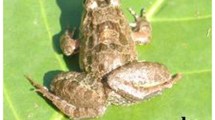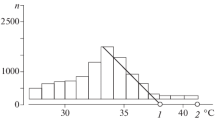Abstract
The diurnal behaviour of frogs was recorded quantitatively in a habitatlike experimental environment by a new method of automatic registration via thermocouples. Three species with different habitat preferences during their summer activity period were chosen: the terrestrial common frog Rana temporaria LINNÈ and the semiaquatic water frog Rana lessonae CAMERANO and Rana ridibunda PALLAS. The activity, the location and the skin temperatures of these frogs were recorded continuously in four different temperature ranges (8.1° C–31.0° C) within the temperature span of the summer activity period. The thermal requirements and behavioural adaptations to the habitat of each species were analysed. The experimental results coincided with field observations and showed some details not yet known. The northern species R. temporaria exhibited a distinctive behavioural thermoregulation including cooling behaviour at high temperatures and warming behaviour at low temperatures during the day. In all temperatures tested these frogs remained on land changing their preferred location from the open area to the hiding places. The main activity period shifted from night to day with decreasing temperatures. The more southern species R. lessonae preferred higher temperatures than the other species showing basking behaviour during the day independent of the ambient temperature. With decreasing temperatures the preferred location changed from the shore to the water and the activity during the night almost disappeared. The closely related R. ridibunda tolerated high temperatures too, but only rarely basked. This species, however, reacted contrarily to decreasing temperatures: it changed its preference from the water to the land. This behavioural differenciation between the water frog species may be of importance for the actual habitat preference of these central european water frogs.
Similar content being viewed by others
References
Berger L (1983) Western palearctic water frogs (Amphibia, Ranidae): Systematics, genetics and population compositions. Experientia 39:127–130
Brattstrom BH (1963) A preliminary review of the thermal requirements of amphibians. Ecology 44:238–255
Brattstrom BH (1979) Thermal acclimation in australian amphibians. Comp Biochem Physiol 35:69–103
Brattstrom BH (1979) Amphibian temperature regulation studies in the field and laboratory. Am Zoologist 19:345–356
Fitzgerald GJ, Bider JR (1974) Influence of moon and weather factors on locomotory activity in Bufo americanus. Oikos 25:338–340
Fromm PO (1956) Heat production in frogs. Physiol Zool 29:234–240
Lagerspetz KYH (1977) Interaction of season and temperature acclimation in the control of metabolism in amphibia. J Thermal Biol 1:204–212
Lillywhite HB (1970) Behavioural temperature regulation in the bullfrog, Rana catesbeiana. Copeia 1970:158–168
Loman J (1981) Spacing mechanisms in a population of the common frog Rana temporaria during the non-breeding period. Oikos 37:225–227
Meissner K (1983) Circadiane Rhythmen von Lokomotion, Atmungsaktivität und Pupillenmotorik bei der Kröte Pelobates fuscus LAUR. Zool Jb Physiol 87:297–308
Mertens R (1947) Die Lurche und Kriechtiere des Rhein-Main-Gebietes. Senckenberg Buch 16, Kramer Verlag Frankfurt
Pearson OP, Bradford DF (1976) Thermoregulation of lizards and toads at high altitudes in Perú. Copeia 1976:155–170
Savage RM (1961) The evology and life history of the common frog (Rana temporaria temporaria). Pitman (London)
Sinsch U (1979) Jahreszeitlich gebundenes Verhalten von Rana temporaria, unter besonderer Berücksichtigung von Temperatureinflüssen. Diplom Thesis, University of Cologne
Strübing H (1954) Über Vorzugstemperaturen von Amphibien. Morph Ökol tiere 43:357–386
Tunner HG (1976) Agressives Verhalten bei Rana ridibunda, Rana lessonae und der hybriden Rana esculenta. Zool Anz 196:67–79
Valdivieso D, Tamsitt JR (1974) Thermal relations of the neotropical frog Hyla labialis (Anura: Hylidae). Life Sciences Occas Pap Royal Ontario Mus 26:1–10
Zimka J (1974) Predation of frogs, Rana arvalis NILSSON, in different forest site conditions. Ekol Pol 22:31–63
Author information
Authors and Affiliations
Rights and permissions
About this article
Cite this article
Sinsch, U. Thermal influences on the habitat preference and the diurnal activity in three European Rana species. Oecologia 64, 125–131 (1984). https://doi.org/10.1007/BF00377554
Received:
Issue Date:
DOI: https://doi.org/10.1007/BF00377554




